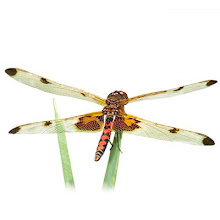Haploa sp.
June 17, 2008
I kicked up quite a few moths (and found a few perched on top of leaves, looking very much like a brown area of leaf damage) while walking through prairie plants. An unmarked Haploa flew at my approach when I was 8' to 10' away. I followed it for a while, each time as I got close (but still too far for a good photo), it would fly away – sometimes just a few feet, sometimes up to 30', but the white inch-and-a-half wingspan was easy to follow. After several chases interspersed with breaks to photograph a geometrid moth and a milkweed beetle, I once again failed to sneak up close enough for a frame-filling image of the Haploa despite slowly crawling through the 2' tall vegetation.
Feeling guilty about repeatedly flushing the moth, I decided that I'd make one last approach and then leave it alone. But when I was about 10' from the moth, I noticed a clubtail perched on the plants just about halfway between me and the moth. I immediately decided to abandon my pursuit of the moth in favor of Cobra Clubtail (Gomphus vastus) photos. I snapped one from where I was and then crept closer to the clubtail for better shots.
Now I was only 5' from the moth, its average level of tolerance, but because of its position in the vegetation, it wasn't very visible and I wasn't even looking for it anymore. Suddenly it bolts – at least by its definition of bolting – which is actually a slow flutter. My eyes instinctively leave the clubtail to glance at the moth – just in time to see that I'm not the only one who noticed it. My reflexes aren't quick enough for a photo – all I could do was scream “NO!” inside my head as the clubtail screamed “LUNCH!” and flew to the top of the nearby oak tree.
Later in the day, I found a dead mole alongside the trail and took photos of flies laying eggs on the carcass.
New species for the year:
Painted Lichen Moth
Cobra Clubtail
Van Meter State Park
June 11, 2008
Found a Stilt-legged Fly (Micropezidae) waving its front legs with white tarsi in front of its head in an effort to resemble a wasp. It's thought that looking like a wasp provides some protection against predators.
Blacklighting for Moths at Overton Bottoms, Big Muddy National Wildlife Refuge
June 10, 2008
Highlight of the evening – prize find of the night goes to Jim who found an Eyed Paectes (Paectes oculatix) feeding on the bait we put out.
skip to main |
skip to sidebar
Prints are available for homes or businesses. Note cards and trading cards are also available. Growth charts are a new item.
My insect photographs are available for licensing to publishers. Unless otherwise noted, all entries refer to mid-Missouri insects.
A selection of my images and a list of species I've photographed are available on my web site.
My insect photographs are available for licensing to publishers. Unless otherwise noted, all entries refer to mid-Missouri insects.
A selection of my images and a list of species I've photographed are available on my web site.
My images are available on t-shirts from CafePress (hhttp://www.cafepress.com/butterfly_shirts)









No comments:
Post a Comment